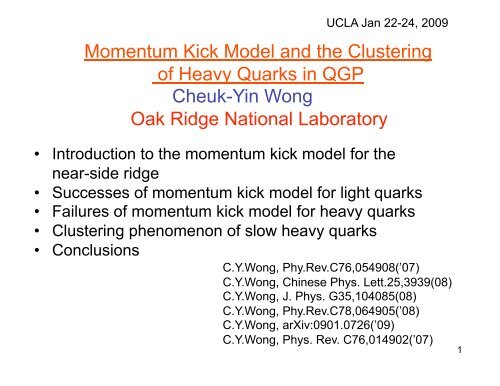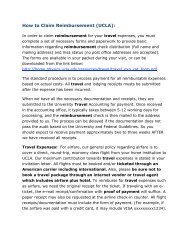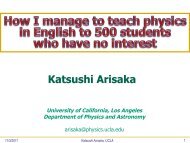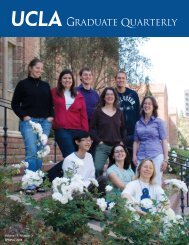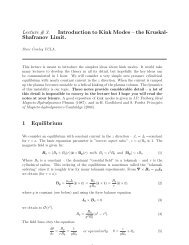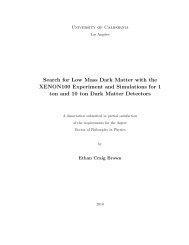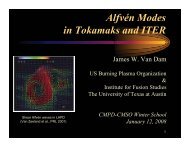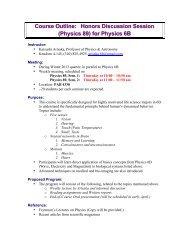Momentum Kick Model and the Quenching of Charm Quark
Momentum Kick Model and the Quenching of Charm Quark
Momentum Kick Model and the Quenching of Charm Quark
You also want an ePaper? Increase the reach of your titles
YUMPU automatically turns print PDFs into web optimized ePapers that Google loves.
UCLA Jan 22-24, 2009<br />
<strong>Momentum</strong> <strong>Kick</strong> <strong>Model</strong> <strong>and</strong> <strong>the</strong> Clustering<br />
<strong>of</strong> Heavy <strong>Quark</strong>s in QGP<br />
Cheuk-Yin Wong<br />
Oak Ridge National Laboratory<br />
• Introduction to <strong>the</strong> momentum kick model for <strong>the</strong><br />
near-side ridge<br />
• Successes <strong>of</strong> momentum kick model for light quarks<br />
• Failures <strong>of</strong> momentum kick model for heavy quarks<br />
• Clustering phenomenon <strong>of</strong> slow heavy quarks<br />
• Conclusions<br />
C.Y.Wong, Phy.Rev.C76,054908(’07)<br />
C.Y.Wong, Chinese Phys. Lett.25,3939(08)<br />
C.Y.Wong, J. Phys. G35,104085(08)<br />
C.Y.Wong, Phy.Rev.C78,064905(’08)<br />
C.Y.Wong, arXiv:0901.0726(’09)<br />
C.Y.Wong, Phys. Rev. C76,014902(’07)<br />
1
What is <strong>the</strong> ridge phenomenon<br />
jet<br />
ridge<br />
• Particles are detected associated with<br />
a near-side trigger<br />
• Δφ=φ (particle)- φ (trigger jet)<br />
Δη=η (particle)- φ (trigger jet)<br />
Δφ<br />
Δη<br />
Find: Δφ- Δη correlation<br />
Probability distribution P(Δφ, Δη ) is in <strong>the</strong> form <strong>of</strong><br />
(i) a “jet component”<br />
(ii) a “ridge component”.<br />
Putschke et al. (STAR) J.Phys..G74 S679(’07)<br />
2
Many Ridge <strong>Model</strong>s<br />
• S.A.Voloshin, Phys. Lett. B632, 490 (`06)<br />
• C.Y.Wong, Phy.Rev.C76,054908(’07);arXiv:0712.3282;arxiv:0806.2154(’08)<br />
• E. Shuryak, C76, 047901 (`07)<br />
• V. S. Pantuev, arxiv:0710.1882<br />
• R.C. Hwa, arXiv:0708.1508<br />
• Nestor Armesto, Carlos A. Salgado, Urs Achim Wiedemann, Phys.<br />
Rev. C 76, 054908 (2007)<br />
• Adrian Dumitru, Yasushi Nara, Bjoern Schenke,<br />
Michael Strickl<strong>and</strong>, arXiv:0710.1223<br />
• A. Majumder, B. Müller, <strong>and</strong> S. A. Bass, Phys. Rev. Lett. 99,<br />
042301 (2007)<br />
• R. Mizukawa, T. Hirano, M. Isse, Y. Nara, A. Ohnishi,<br />
arXiv:0805.2795<br />
• Sean Gavin, Larry McLerran, George Moschelli, arXiv:0806.4718<br />
• A. Dumitru,F. Gelis, L. McLerran, <strong>and</strong> R. Venugoplan, arxiv:<br />
0804.3858.<br />
• •••• many more<br />
3
Experimental observations <strong>and</strong> <strong>the</strong>ir implications<br />
• (i) Ridge yield correlated with N_participants<br />
• (ii) Ridge yield nearly independent <strong>of</strong> pt trigger,<br />
flavor, baryon, light meson characters <strong>of</strong> <strong>the</strong> jet<br />
• (iii) Brayon/meson ratios in <strong>the</strong> ridge <strong>and</strong> in inclusive bulk are similar<br />
• (iv) T_ridge is similar to T_inclusive but slightly higher<br />
~<br />
→ ridge particles are medium partons<br />
• (v) Δφ ~ 0 implies that <strong>the</strong> ridge particles acquire <strong>the</strong>ir azimuthally<br />
properties from <strong>the</strong> jet<br />
• (vi) jet-(medium parton) interactions are short-ranged because <strong>of</strong><br />
non-perturbative screening<br />
→ ridge particles are medium partons kicked by <strong>the</strong> jet<br />
<strong>and</strong> <strong>the</strong>y acquire a momentum kick q along <strong>the</strong> jet<br />
direction<br />
4
Schematic picture <strong>of</strong> <strong>the</strong> momentum kick model<br />
jet<br />
ridge<br />
Δφ<br />
Δη<br />
5
The momentum kick model<br />
6
<strong>Momentum</strong> kick model described well STAR near-side data<br />
around Δη~0<br />
Data from STAR Collaboration<br />
PRL95,152301(05) & J. Phy. G34, S679 (07)<br />
8
Parton momentum distribution<br />
at <strong>the</strong> moment <strong>of</strong> jet-parton collision<br />
9
Ridge yield is a maximum at Δφ~0<br />
10
<strong>Momentum</strong> kick model described well STAR near-side data<br />
around Δη~0<br />
Data from STAR Collaboration<br />
PRL95,152301(05) & J. Phy. G34, S679 (07)<br />
11
<strong>Momentum</strong> kick model described well STAR near-side data<br />
around 2.7
<strong>Momentum</strong> kick model gives <strong>the</strong> correct prediction<br />
for <strong>the</strong> PHOBOX data<br />
Data from Wenger et al.(J.Phys.G35,104080(’08)<br />
13
ptrig=2-3GeV<br />
ptrig=3-4GeV<br />
ptrig=4-5GeV<br />
PHENIX Data<br />
ptrig=5-10GeV<br />
14
STAR preliminary heavy quark data<br />
CuCu at sqrt(s)=200 GeV<br />
0.15
STAR preliminary heavy quark data<br />
AuAu at sqrt(s)=200 GeV<br />
0.15
CuCu<br />
PYTHIA results<br />
AuAu<br />
Jet component associated with heavy quark is small.<br />
G.Wang et al. J.Phys. G35, 104107(’08)<br />
18
<strong>Momentum</strong> kick model fails to reproduce STAR particle<br />
near-side yields associated with heavy quarks<br />
Experimnetal large associated particle yield suggests<br />
collective medium excitation by heavy quarks<br />
19
Clusters surrounding a charge Q in a plasma<br />
An external charge Q polarizes <strong>the</strong> plasma medium<br />
Medium charges <strong>of</strong> <strong>the</strong> same sign are pulled toward Q.<br />
Medium charges <strong>of</strong> <strong>the</strong> opposite sign are pushed away from Q.<br />
This is <strong>the</strong> familiar Debye screening with a screening radius r D<br />
There is no net change <strong>of</strong> total medium density, to <strong>the</strong> first order<br />
<strong>of</strong> (α/r D T) .<br />
However, <strong>the</strong> second order term (α/r D T) 2 has <strong>the</strong> same sign for<br />
charges <strong>of</strong> both signs. There is a net increase in total density<br />
surrounding Q.<br />
This increase in polarization charges can be large in a dense<br />
medium.<br />
20
A simple model <strong>of</strong> charge clustering<br />
• Q<br />
(charge +q) at -R/2<br />
• Q (charge –q) at R/2<br />
• medium: e + (charge +q), e - (charge –q)<br />
• particles interact with an e 1 e 2 /r interaction<br />
We assume e + <strong>and</strong> e - are massless <strong>and</strong> are<br />
fermions.<br />
We also assume local <strong>the</strong>rmal equilibrium<br />
21
1000<br />
TS 1 [MeV]<br />
(b)<br />
500<br />
0<br />
R (fm)<br />
r [fm<br />
0 0.5 1 1.5<br />
Lattice gauge calcualtions <strong>of</strong> TS 1 =U 1 -F 1 .<br />
O. Kaczmarek et al. hep-lat/0506019<br />
C.Y.Wong,Phys.Rev.C76,014902(’07)<br />
24
(1)<br />
Simple estimates <strong>of</strong> heavy quark parton cluster<br />
(2)<br />
25
Implications <strong>of</strong> a heavy quark parton cluster<br />
• The motion <strong>of</strong> <strong>the</strong> heavy quark is that <strong>of</strong> a cluster <strong>of</strong><br />
particles <strong>and</strong> not just a single particle.<br />
• The color charge <strong>of</strong> <strong>the</strong> heavy quark is substantially<br />
screened by <strong>the</strong> cluster <strong>of</strong> medium charges.<br />
• The clustering will enhance <strong>the</strong> (heavy-quark)-parton<br />
cross section by <strong>the</strong> presence <strong>of</strong> associated particles.<br />
• The degree <strong>of</strong> clustering will decrease in strength as <strong>the</strong><br />
p t <strong>of</strong> <strong>the</strong> heavy quark increases. Associated near-side<br />
cluster yield decreases with increasing heavy quark pt.<br />
• The cluster <strong>of</strong> particles show up experimentally as<br />
associated particles in coincidence with <strong>the</strong> heavy quark.<br />
These associated particles has characteristics different<br />
from those associated with a light quark.<br />
26
Conclusions<br />
The momentum kick model<br />
• describes near-side ridge data with light quark triggers<br />
• provides information on early medium properties <strong>and</strong> jetmedium<br />
interaction<br />
• fails to describe near-side ridge data with heavy quark<br />
(electron) trigger<br />
Recent STAR near-side heavy quark jet data observations<br />
• Number <strong>of</strong> associated with heavy quark is large<br />
• CuCu yield is large relative to AuAu yield<br />
There exists <strong>the</strong> clustering <strong>of</strong> medium particles surrounding<br />
heavy quarks<br />
We should explore whe<strong>the</strong>r parton clustering may be a possible<br />
origin <strong>of</strong> <strong>the</strong> STAR observation <strong>of</strong> large number <strong>of</strong> particles<br />
associated with heavy quarks<br />
27
Additional details<br />
28
Basic ideas <strong>of</strong> <strong>the</strong> momemtum kick model<br />
• Ridge particles are medium partons kicked by<br />
<strong>the</strong> jet <strong>and</strong> <strong>the</strong>y acquire a momentum kick q<br />
along <strong>the</strong> jet direction<br />
• The kicked final partons subsequently<br />
materialize as hadrons by parton-hadron duality<br />
• The ridge particle distribution depends on <strong>the</strong><br />
initial parton momentum distribution <strong>and</strong> <strong>the</strong><br />
magnitude <strong>of</strong> <strong>the</strong> momentum kick q.<br />
30
The width in Δφ depends on <strong>the</strong> magnitude <strong>of</strong> q.<br />
at pt=2 GeV<br />
32
To describe experimental data, we need<br />
1. A good description <strong>of</strong> <strong>the</strong> “jet” component<br />
2. A good description <strong>of</strong> <strong>the</strong> shape <strong>of</strong> <strong>the</strong><br />
normalized initial momentum distribution<br />
3. We can <strong>the</strong>n determine <strong>the</strong> jet-medium<br />
interaction parameters by comparison with<br />
data:<br />
q, f R , f J<br />
33
Centrality depedence <strong>of</strong> R AA & ridge yield<br />
36
Distribution <strong>of</strong> <strong>the</strong> number <strong>of</strong> jet-(medium parton) collisions<br />
37
The momentum kick model gives a good description <strong>of</strong> R AA<br />
38
Centrality dependence in <strong>the</strong> momentum kick model<br />
39
Energy <strong>and</strong> mass dependence in <strong>the</strong> momentum kick model<br />
40
Possible evolution scenario <strong>of</strong> medium partons<br />
41


